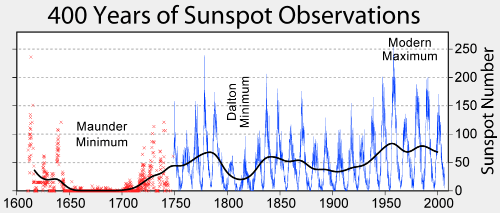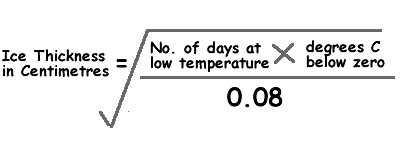Ice Damage to Pools in Winter
I. How Big a Threat is this?
The very short answer to this question is that any swimming pool located anywhere that ice thickness is likely to exceed 5cm is vulnerable to being damaged in the winter if special precautions are not taken.
Let's Have a Quick Look at the Climate Issue
First of all let's get global warming out of the way.
Our view is this:-
- Man is creating too much CO2 and the rate of increase needs to be curtailed - the real problem is how much society can afford and still alleviate poverty and hunger
- The relationship between the level of CO2 in the atmosphere and global temperatures is unknown at the present simply because mankind does not yet have the processing power to accurately simulate the global climatic conditions
You will have your own views but if you are convinced that we will never have another cold winter because of global warning I would leave this page now because there is no point in you reading on.
The Northern Hemisphere Climate Cycle
Sunspots
If you look at the following graph you will see that our Northern Hemisphere Climate is affected by sunspot activity. Putting it crudely, the more sunspots there are, the brighter the sun is and the hotter the weather.

The Maunder minimum is associated with the mini Ice Age in the late 1600's when they used to hold fairs on the River Thames in the winter, and there were similar conditons during the 1800's associated with the Dalton Minimum
There is little doubt that the steady increase in temperature from 1900 to 1950 is predominantly caused by the increase in sunspot activity and probably by global warming but we just do not know how much can be attributed to each factor.
The most prominent feature of the graph is the 11 year cycle that shows minimums in sunspot activity in the years 1953-1954, 1964-1965, 1975-1976, 1986-1987, 1997-1998 and 2008-2009. The cycle length itself is not important because it is the height of the peaks in the graph that effect the temperatures on earth.
We proably had very cold winters in the early 1960's and 1970's because of the low peak in sunspot activity around 1970. The peaks in the 1940's, 1950's, 1980's, 1990's were the highest since the 1800's.
We had a much lower peak in the early 2000's and it is quite possible that the next peak will be even lower.
Why haven't pools been damaged by ice in the past?
The answer to this is simple - we have not had a severe winter since 1981 - 82 and there were virtually no outdoor pools in England at that time. However since then, over 100,000 have been built and in France where the winter temperatures are just as low as in the UK over 1 million have been built!
The other thing that I do know because I remember it quite distictly is that the old outdoor swimming pools - or lidos as we called them when I was a kid - were all emptied in the winter!
In 2009 - 2010 we were very close to pool damage territory but we never quite had the low temperatures for long enough.
I have a concrete tank in my garden that collects rainwater that runs off my roof. I kept monitoring the ice thickness and it never got thicker than 6 centimetres and so not quite into the danger area as we will see later.
II. The Science Behind It
When water turns to ice it increases in volume by about 9% and so in a 10m x 5m pool a sheet of ice across the surface of the pool will try and increase its size to nearly 11 m x 5.5 m!!!
An ice sheet forming across set of pool access steps in the form of a Roman or Greek end that are 3m wide will want to expand to just over 3.25 metres wide.
What actually happens is that the ice is only a thin sheet to start with and it does not start to act as a rigid strut until the ice gets to about 20 or 30mm thick and so there is no real pressure on the pool walls until that stage is reached.
The ice sheet's resistance to bending increases with the cube of the ice thickness (thickness x thickness x thickness) so that an ice sheet 4 inches or 100mm thick can impose a load 64x higher than an ice sheet that is 1 inch thick. When the ice is 6 inches thick, this increases to 216 times as much !!!
This effect is increased because as the ice gets thicker and colder it's strength also increases. So as the ice gets thicker its strength as a horizontal strut increases very rapidly for every extra inch of thickness.
The forces exerted by the ice are very difficult to calculate exactly but if the ice is 100 mm or 10 cm thick, the outward expansion forces on the pool walls could be as high as 50 tonnes per metre of pool wall - this would absolutely wreck any swimming pool structure.
What governs the thickness of the ice?
This is also very interesting and can be roughly calculated using the following formula :-

Please click here to see how this formula is derived.
As such, if the water temperature is continously at 2° below zero for 4 days the ice thickness will be the square root of 4 x 2 / 0.08 = 10 cm or 100 mm.
There are two things that can influence this rate of ice build up.
The first is water purity - for instance ocean salt water freezes on average at about -2°C.
In these circumstances the equation should be changed so that the water temperature is in °C below the actual freezing point of the water under consideration.
The second is that the formula assumes that the water below the ice is at freezing temperature. In a pool that might be on average a metre or more deep, the colder water just under the ice layer will keep dropping down to the bottom of the pool because the cold water is heavier. So the water in the pool will need to be continuously mixed until it is all at the same temperature.
As such, shallow water will freeze quicker than deeper water - but this effect only delays ice build by a relatively short period and so does not really reduce the risk at all.
Cold winters and pool damage by ice:
Although we had a pretty cold winter in 2009/2010 (as shown here) we did not have a prolonged period of very low temperatures such that would have produced massive ice damage in swimming pools.
And if we have one winter like 1962-63 when the temperature never got above freezing for 3 months every single pool that has not been emptied will be totally wrecked.
III. The Implications for the Design of Pool Structures
The implication for the design of any pool structure are quite stark.
If winters in the UK and France get a lot colder over the next few years all pools may need to be emptied in the winter.
However, it is possible to mitigate the effects of ice sheets in swimming pools by:
- Winterising the pool properly
- Using large pieces of floating polystyrene or special anti -ice "air ballons"
- Covering the entire surface of the pool with polystyrene blocks to ensure that the pool water is sufficiently insulated for it to never freeze.
- Adding anti-freeze to the water - at massive cost - and then you have to swim in it or empty the pool in spring anyway
- Installing an automatic floating cover that will insulate the pool water and allow a water heating system to be run whenever the temperature gets low
- Breaking up the ice by hand as it forms
The installation of an automatic floating cover is by far the best solution as this will pay for itself by reducing water heating costs as well.
But But But !!!
- Many kit pools cannot be emptied because the walls can collapse.
- Fibreglass pools cannot be emptied because they will pop out of the ground.
- Tiled pools can be damaged by quite thin ice because the tiles can crack along the water line.
- Tiled pools cannot be emptied because all the tiling will be forced off the pool walls by water freezing behind them.
Just Remember that
- PolyBlok pools will be completely safe when empty because of the slabs that anchor the tops of the walls rigidly in place irrespective of whether the pool is empty or not.
- Bluepools will provide a written winterisation procedure for every pool that they design and this will include detailed instructions on how to empty your pool.
- If the weather forcasts imply that a prolonged period of very low temperatures is likely, every owner of a PolyBloK will be able to simply empty it and save it.
